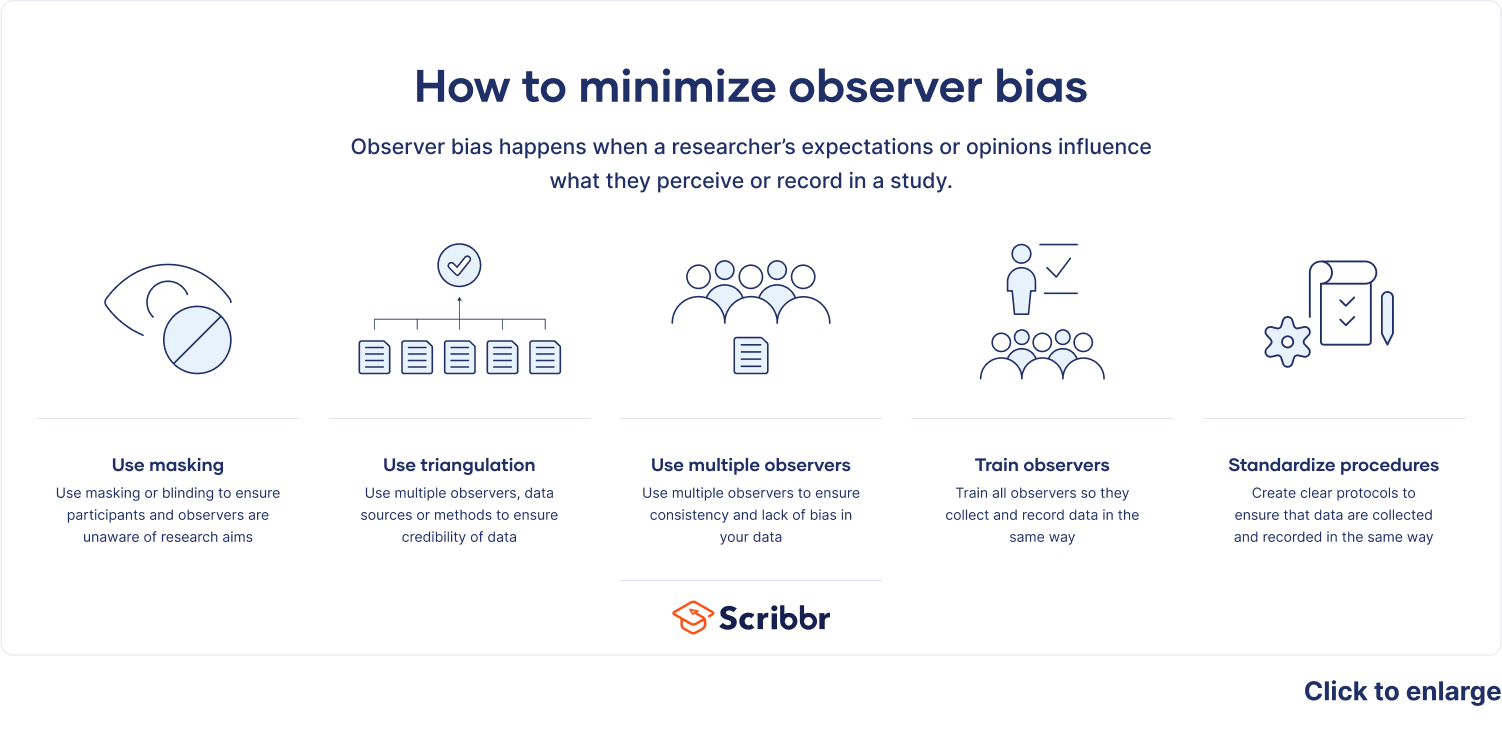Observer Bias | Definition, Examples, Prevention
Observer bias happens when a researcher’s expectations, opinions, or prejudices influence what they perceive or record in a study. It often affects studies where observers are aware of the research aims and hypotheses. Observer bias is also called detection bias.
Observer bias is particularly likely to occur in observational studies. But this type of research bias can also affect other types of research where measurements are taken or recorded manually.
What is observational research?
In observational studies, you often record behaviours or take measurements from participants without trying to influence the outcomes or the situation. Observational studies are used in many research fields, including medicine, psychology, behavioural science, and ethnography.
Observer bias can occur regardless of whether you use qualitative or quantitative research methods.
Subjective methods
Subjective research methods involve some type of interpretation before you record the observations.
In any research involving others, your own experiences, habits, or emotions can influence how you perceive and interpret others’ behaviours. They may lead you to note some observations as relevant while ignoring other equally important observations.
You note down and interpret different types of interactions between the children and conclude that they spent most of the time sharing the toy and having positive interactions. Your colleague, however, disagrees, finding that most of their exchanges seemed unfriendly.
Your expectations about the research may lead to skewed results. There’s a risk you may be subconsciously primed to see only what you expect to observe.
Objective methods
Observer bias may still influence your study even when you use more objective methods (e.g., physiological devices, medical images) for measurement.
That’s because people have a tendency to interpret readings differently, so results can vary between observers in a study.
A lack of training, poor control, and inadequate procedures or protocols may lead to systematic errors from observer bias.
Observer drift
As you collect data, you become more familiar with the procedures and you might become less careful when taking or recording measurements. Observer drift happens when observers depart from the standard procedures in set ways and therefore rate the same events differently over time.
How to minimise observer bias
It’s important to design research in a way that minimises observer bias. Note that, while you can try to reduce observer bias, you may not be able to fully eliminate it from your study.
Use masking
Masking, or blinding, helps you make sure that both your participants and your observers are unaware of the research aims.
This can remove some of the research expectations that come from knowing the study purpose, so observers are less likely to be biased in a particular way.
You can implement masking by involving other people in your studies as observers and giving them a cover story to mislead them about the true purpose of your study.
Use triangulation
Triangulation means using multiple observers, information sources, or research methods to make sure your findings are credible. It’s always a good idea to use triangulation to corroborate your measurements and check that they line up with each other.
To reduce observer bias, it’s especially important to involve multiple observers and to try to use multiple data collection methods for the same observations. When the data from different observers or different methods converge, you reduce the risk of bias and can feel more confident in your results.
Multiple observers
With more than one observer, you make sure that your data are consistent and unlikely to be skewed by any single observer’s biases.
When you have multiple observers, it’s important to check and maintain high interrater reliability. Interrater reliability refers to how consistently multiple observers rate the same observation.
With quantitative data, you can compare data from multiple observers, calculate interrater reliability, and set a threshold that you want to meet. Usually, you train observers in the procedures until they can consistently produce the same or similar observations for every event in training sessions.
Train observers
Before you start any study, it’s a good idea to train all observers to make sure everyone collects and records data in exactly the same way.
It’s important to calibrate your methods so that there’s very little or no variation in how different observers report the same observation. You can recalibrate your procedures between observers at various points in the study to keep interrater reliability high and minimise observer drift as well.
Standardise your procedures
It’s best to create standardised procedures or protocols that are structured and easy to understand for all observers. For example, if your study is about behaviours, make sure to specify all behaviours that observers should note.
Record these procedures (in videos or text) so you can refer back to them at any point in the research process to refresh your memory.
Other biases
Observer bias is closely related to several other types of research bias.
Observer-expectancy effect
The observer-expectancy effect occurs when researchers influence the results of their own study through interactions with participants.
Researchers may unintentionally signal their own beliefs and expectations about the study and influence participants through demand characteristics.
The observer-expectancy effect also goes by other names:
- Experimenter-expectancy effect
- Rosenthal effect
- Pygmalion effect
- Group A receives the actual treatment with the new painkiller
- Group B receives no treatment, but instead takes a placebo
The participants don’t know whether they’re part of Group A or B, but you do. Unconsciously, you treat the two groups differently while conducting a survey about their level of back pain. You treat Group B as if you expect the participants to still be in pain and frame your questions more negatively than for Group A.
Actor–observer bias
The actor–observer bias is an attributional bias where you tend to attribute the cause of something differently depending on whether you’re the actor or observer in that situation.
As an actor in a situation, you may tend to attribute your own behaviour to external factors. As an observer, you may instead attribute another person’s behaviour, even if it’s the same as yours, to internal factors. The actor–observer bias is a social psychological topic.
A couple of weeks later, you observe another colleague feeling the same way, but you attribute it to their own personality, work ethic, and lack of drive (all internal factors).
Hawthorne effect
The Hawthorne effect refers to some research participants’ tendency to work harder in order to perform better when they believe they’re being observed. It describes what participants being observed may inadvertently do in a study.
The Hawthorne effect is named after Hawthorne Works, a company where employee productivity supposedly improved, regardless of the experimental treatment, due to the presence of observers.
The teacher and students are aware of the principal observing them, which causes the students to behave better and the teacher to try harder. As a result, the principal’s observations are not in line with typical behavioural patterns in the classroom.
Experimenter bias
Experimenter bias covers all types of biases from researchers that may influence their studies. This includes observer bias, observer expectancy effects, actor–observer bias, and other biases. Experimenter bias is also called experimenter effect.
Other types of research bias
Frequently asked questions about observer bias
- What is the definition of observer bias?
-
Observer bias occurs when a researcher’s expectations, opinions, or prejudices influence what they perceive or record in a study. It usually affects studies when observers are aware of the research aims or hypotheses. This type of research bias is also called detection bias or ascertainment bias.
- How can I minimise observer bias in my research?
-
You can use several tactics to minimise observer bias.
- Use masking (blinding) to hide the purpose of your study from all observers.
- Triangulate your data with different data collection methods or sources.
- Use multiple observers and ensure inter-rater reliability.
- Train your observers to make sure data is consistently recorded between them.
- Standardise your observation procedures to make sure they are structured and clear.
- What is the observer-expectancy effect?
-
The observer-expectancy effect occurs when researchers influence the results of their own study through interactions with participants.
Researchers’ own beliefs and expectations about the study results may unintentionally influence participants through demand characteristics.
Cite this Scribbr article
If you want to cite this source, you can copy and paste the citation or click the ‘Cite this Scribbr article’ button to automatically add the citation to our free Reference Generator.
Bhandari, P. (2023, March 13). Observer Bias | Definition, Examples, Prevention. Scribbr. Retrieved 9 December 2024, from https://www.scribbr.co.uk/bias-in-research/observer-bias-explained/

